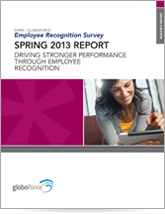As regular readers can imagine, I’m a big fan of research.
Research from multiple angles and sources can lead us to better decisions and applications. In addition to the external research I make a practice to seek out (from the usual suspects of Towers Watson, Hay Group, Mercer, Deloitte, etc.), I also greatly enjoy the semi-annual research Globoforce conducts with SHRM on the employer/management take on the current state of employee engagement, retention, performance, organization culture and the like.
Our most recent survey just came out. The Spring 2013 Report — Driving Stronger Performance through Employee Recognition — uncovered several interesting findings as featured in the press release about the report:
1. Crowdsourced feedback and recognition can address the limitations of traditional performance reviews.
Of the companies surveyed, 77 percent conduct performance reviews once a year. Still, employees overwhelmingly feel more frequent reviews by multiple sources would provide more accurate input and create a more effective recognition program. Key findings include:
- 85 percent of companies are currently using or would considering using social recognition (a system that empowers employees to recognize each other for great work).
- 78 percent say crowdsourced recognition would be helpful data to incorporate into performance reviews.
- 74 percent currently use or would consider mapping recognition awards against performance rankings/ratings.
2. Investment in recognition programs lowers workforce frustration and boosts employee productivity.
Data from the survey shows a connection between employee productivity and satisfaction and a company’s recognition program spend. According to respondents, higher budget allocations result in less frustrated and more productive employees. Employees at companies that invest more than one percent of payroll in a recognition program are:
- Nearly twice as likely to report increased employee productivity at their company (versus companies that spend less than 1 percent of payroll on recognition).
- Nearly 50 percent less likely to say they are often or very frustrated with their work environment (compared to employees at companies that spend less than 1 percent of payroll on recognition).
3. Praise coupled with a prize is the most powerful motivator.
Praise is a powerful motivator for employees. When that praise is coupled with a prize, employees’ performance is driven even further. SHRM/Globoforce survey findings include:
- 83 percent say employees are further motivated by recognition that includes a reward than recognition with no associated reward (i.e. “free” recognition).
- 94 percent of respondents say positive feedback has a greater impact on performance (versus just six percent who say negative feedback is the better motivator)
I encourage you to check out the full report for more details.
You can find more from Derek Irvine on his Recognize This! blog.
